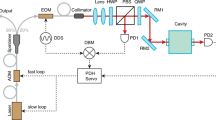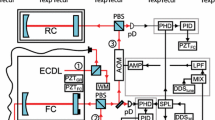Abstract
Purpose
Currently, the calibration for astronomical telescopes requires a broad wavelength range of several hundred nanometers. Therefore, a simple and compact wavelength broadening device is applied to generate a variety of wavelengths. In addition, a beam stabilization system is designed to automatically correct the beam deviation due to vibration and temperature fluctuation.
Methods
We broaden the laser spectrum by nonlinear effect between the noble gas in a hollow-core fiber and the laser electric field. By selecting the species and pressure of the noble gases, one can control the spectral broadening. The active beam stabilization system consists of two mirror mounts with motorized actuators and two CCD cameras. After acquiring the centroid of the laser beam and comparing it with the target position, an algorithm is implemented to correct the beam pointing.
Results
Both experimental and simulation results show that the spectral range of the laser is greatly broadened. Besides, we have attained the phase of pulses. These parameters can be used to monitor the laser’s running status over time. The active stabilization system can quickly correct the deviation of beam pointing and simultaneously obtain the beam profile, allowing for nominally perfect control of the beam.
Conclusion
In our design, both the broadband laser source and beam stabilizer are involved in the laser calibration system, providing us with various wavelengths and a high-precision pointing with outstanding intrinsic long-term stability.











Similar content being viewed by others
References
C. Lovis, M. Mayor, F. Pepe et al., An extrasolar planetary system with three Neptune-mass planets. Nature 441, 305 (2006). https://doi.org/10.1038/nature04828
Z. Cao, A future project at Tibet: the large high altitude air shower observatory (LHAASO). Chin. Phys C 34, 249 (2010). https://doi.org/10.1088/1674-1137/34/2/018
J. Abraham et al., Properties and performance of the prototype instrument for the Pierre Auger Observatory. Nucl. Instr. and Meth. A 523, 50 (2004). https://doi.org/10.1016/j.nima.2003.12.012
R. Carlberg, An overview on extremely large telescope projects. PoS of IAU 1(S232), 25 (2005). https://doi.org/10.1017/S1743921306000238
B. Fick et al., The central laser facility at the pierre auger observatory. JINST 1, P11003 (2006). https://doi.org/10.1088/1748-0221/1/11/P11003
F. Aharonian, Q. An, Axikegu, et al., Reconstruction of Cherenkov image by multiple telescopes of LHAASO-WFCTA. Radiat Detect Technol Methods 6, 544 (2022). https://doi.org/10.1007/s41605-022-00342-4
L. Chen et al., Application of the nitrogen laser calibration system in LAASO-WFCTA. PoS ICRC2021 (2021). https://doi.org/10.22323/1.395.0269
Q.N. Sun et al., The YAG lidar system applied in LHAASO. PoS ICRC2021 (2021). https://doi.org/10.22323/1.395.0272
W.X. Pi et al., Extinction coefficients of surface atmospheric aerosol above LHAASO. Chin Phys C 43, 085001 (2019). https://doi.org/10.1088/1674-1137/43/8/085001
M. Nisoli, S. De Silvestri, O. Svelto, Generation of high energy 10 fs pulses by a new pulse compression technique. Appl Phys Lett 68, 2793 (1996). https://doi.org/10.1063/1.116609
Z. Cao et al., Introduction to large high altitude air shower observatory (LHAASO). Chin Astron Astrophys 43, 457 (2019). https://doi.org/10.1016/j.chinastron.2019.11.001
S. Yang et al., Automatic compensation of thermal drift of laser beam through thermal balancing based on different linear expansions of metals. Results Phys 13, 102201 (2019). https://doi.org/10.1016/j.rinp.2019.102201
C. Rolland, P.B. Corkum, Compression of high-power optical pulses. J Opt Soc Am B 5, 641 (1988). https://doi.org/10.1364/JOSAB.5.000641
M. Nisoli et al., A novel-high energy pulse compression system: generation of multigigawatt sub-5-fs pulses. Appl Phys B 65, 189 (1997). https://doi.org/10.1007/s003400050263
M. Nisoli, S. De Silvestri, O. Svelto, R. Szipöcs, K. Ferencz, Ch. Spielmann, S. Sartania, F. Krausz, Compression of high-energy laser pulses below 5 fs. Opt Lett 22, 522 (1997). https://doi.org/10.1364/OL.22.000522
E.A.J. Marcatili, R.A. Schmeltzer, Hollow metallic and dielectric waveguides for long distance optical transmission and lasers. Bell Syst Tech J 43, 1783 (1964). https://doi.org/10.1002/j.1538-7305.1964.tb04108.x
K.W. De Long, R. Trebino, J. Hunter, W EWhite, Frequency-resolved optical gating with the use of second-harmonic generation. J Opt Soc Am B 11, 2206 (1994). https://doi.org/10.1364/JOSAB.11.002206
X.-H. Ma et al., Chapter 1 LHAASO instruments and detector technology. Chin Phys C 46, 030001 (2022). https://doi.org/10.1088/1674-1137/ac3fa6
Y. Wu, D. French, I. Jovanovic, Passive beam pointing stabilization. Opt Lett 35, 250 (2010). https://doi.org/10.1364/OL.35.000250
C.L. Ding, D.Z. Zhu, Z. Wei, M.B. Tang, C.F. Kuang, X. Liu, A compact and high-precision method for active beam stabilization system. Opt Commun 500, 127328 (2021). https://doi.org/10.1016/j.optcom.2021.127328
Z. Yu, K. Zhu, M. Gu et al., Control and monitoring software of LHAASO DAQ. Radiat Detect Technol Methods 6, 227 (2022). https://doi.org/10.1007/s41605-022-00327-3
S. Thomas, T. Fusco, A. Tokovinin, M. Nicolle, V. Michau, G. Rousset, Comparison of centroid computation algorithms in a Shack–Hartmann sensor. Mon Notices R Astron Soc 371, 323 (2006). https://doi.org/10.1111/j.1365-2966.2006.10661.x
H. Chang, W.Q. Ge, H.C. Wang, H. Yuan, Z.W. Fan, Laser beam pointing stabilization control through disturbance classification. Sensors 21, 1946 (2021). https://doi.org/10.3390/s21061946
Acknowledgements
This work is supported by the funding from National Development and Reform Commission in China (Q110522S07001). It is also supported by NSFC (12105233) and by National Key R&D program of China (2018YFA0404201).
Author information
Authors and Affiliations
Corresponding author
Ethics declarations
Conflict of interest
On behalf of all authors, the corresponding author states that there is no conflict of interest.
Rights and permissions
Springer Nature or its licensor (e.g. a society or other partner) holds exclusive rights to this article under a publishing agreement with the author(s) or other rightsholder(s); author self-archiving of the accepted manuscript version of this article is solely governed by the terms of such publishing agreement and applicable law.
About this article
Cite this article
Wang, Y., Xie, L., Sun, Q. et al. The broadband laser source and an active beam stabilization device for laser calibration systems. Radiat Detect Technol Methods 7, 364–371 (2023). https://doi.org/10.1007/s41605-023-00393-1
Received:
Revised:
Accepted:
Published:
Issue Date:
DOI: https://doi.org/10.1007/s41605-023-00393-1




